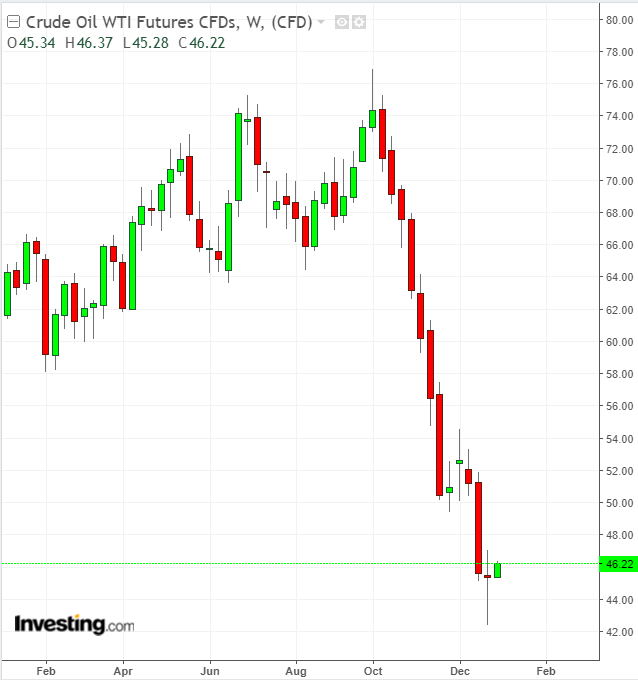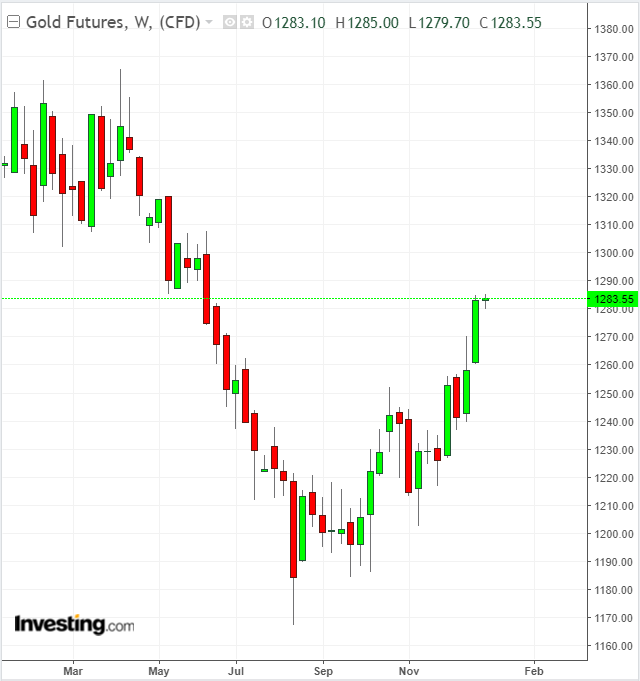That oil will likely end the year with its biggest loss since 2014—down 25 percent—and its worst December since 2015, off 11 percent, is no longer news. What everyone wants to know is how will crude start the New Year and where it will settle at the end of this week.

If last week was any indication, 2019 might be a roller coaster like no other. Just before the Christmas break, the commodity took a 7 percent plunge. That was followed by a 9 percent jump right after the holiday, and a 4 percent slump the very next session.
Volatility was heightened more because of equities than energy. To oil producers’ chagrin, the 1.2 million-barrels-per-day output cut announced on December 7 by the Organization of the Petroleum Exporting Countries (OPEC) and Russia has been neutered by unyielding US production. With little else to go on, oil has behaved more like Wall Street’s Siamese twin: Falling and rising on global recession worries and powerful buybacks prompted by global macro factors, rather than crude production outages in Libya and Venezuela.
Will 2019 Be OPEC’s Year?
That could change in the New Year as traders, back from the holidays with a sharper focus on energy fundamentals, become more sensitive to the machinations of OPEC—which, interestingly, is planning an extraordinary meeting in April (read: another production cut) to apply a new round of upward pressure on the market.
Some, like John Kilduff, founding partner at New York energy hedge fund Again Capital, think 2019 could also bring back something that had been virtually absent the past few months: geopolitical risk. Says Kilduff:
“The US decision to withdraw troops from Syria and Jim Mattis’ resignation as defense secretary from the Trump administration in protest of that are two ticking time-bombs for geopolitical risk in the coming year.”
Helima Croft, global head of commodity strategy at RBC Capital Markets in London, believes oil is on a comeback too, telling a CNBC segment last week: “At some point, I do think fundamentals should reassert themselves in this market.”
Or Will The Bears Continuing Ruling Oil?
Others, like Adam Sarhan, chief executive at global macro fund 50 Park Investments in New York, is advising clients to be cautious of any oil rally story. Says Sarhan: “What’s happening in the fourth quarter now will likely continue in the first quarter of the new year.” He adds:
“Oil and gasoline are both in bear markets and until we see any major bullish catalyst, the path of least resistance will still be lower. There’s no bullish change in fiscal policy or monetary policy that I see on the horizon. We do not have any kind of fixed stimulus coming from global central banks; in fact there’s more tightening, and that’s not good for markets. The sum effect is, six months out, prices could probably be lower than they are today.”
Independent energy analyst and Forbes contributor Gaurav Sharma also has a bearish outlook, saying OPEC continues to underestimate the production of US crude, which grew by two million barrels per day since 2017 to reach a record high 11.7 million bpd. Contingent upon shale decline rates, the US is expected to remain a solid buffer producer to OPEC over the next 5 to 7 years, with forecasts for 12 million bpd in 2019, and 15 million by 2025.
Sharma is cognizant of the fact that the US produces the light, sweet crude that might be perfect for gasoline, and not the “heavier” oil from the Middle East that American refineries need for turning out diesel and other middle distillates. But in a market focused on total production numbers, it is US crude that is determining price direction and it is US crude that will benefit from any rally, the UK-based analyst says.
Thus, if OPEC expands cuts, Sharma says its “desired price range of $60-70 per barrel might well be achieved, but that would encourage higher production Stateside and a loss of market share for some in OPEC.” He adds:
“Apart from issues with its own credibility, the potent problem OPEC is grappling with is that it is damned if it cuts output, and damned if it doesn't, with either move bringing a different kind of crude pain; and all of it for the sake of trying to keep oil prices within a very modest $60-70 range.”
Precious Metals On A Higher Path
Staying on the global macro track, it could be a different story for precious metals.
Gold, which has been on a slow-burn rally since October, is expected to pierce the $1,300 per ounce barrier in the coming weeks and could even get to $1,500 by the first quarter if global recession continue to heighten.

The yellow metal has had nine positive closes in 10 days of trading, boosted by the general slump in equities and worries over the partial US government shutdown since last week. For the year, though, gold remains on track to a 2% loss.
Walter Pehowich, executive vice-president at Dillon Gage Metals in Addison, Texas, says:
"Going into 2019, I expect the price of gold to benefit from geopolitical risks and a softening dollar. I expect physical demand for gold to increase exponentially, as investors watch US debt explode and the costs of entitlements getting totally out of hand as our politicians continue to ignore all the warning signs."
Sarhan of 50 Park Investments concurs, saying he’s been shepherding his clients toward precious metals. Says Sarhan:
“Gold did not rally when oil began rallying 18 months ago and is extremely undervalued. When inflation picks up and you get economic threats or a bear market for oil like now, the natural hedge to run to will be gold.”
